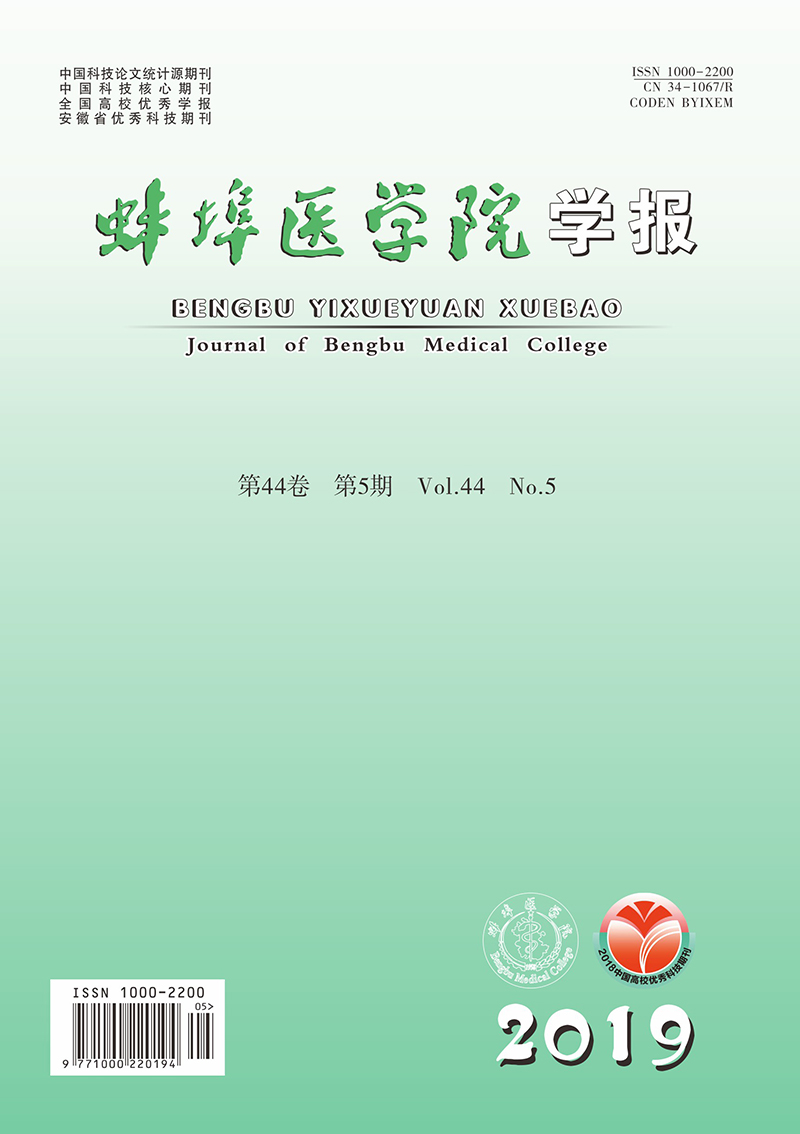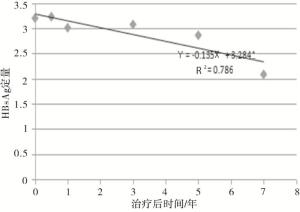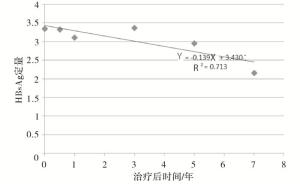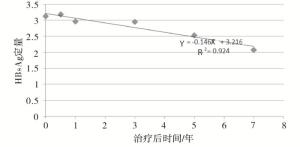-
乙型肝炎病毒(HBV)感染是一个重要的全球公共卫生问题,慢性乙型病毒性肝炎(CHB)可进展为终末期肝病,包括肝硬化、肝功能失代偿及原发性肝细胞癌(HCC)等[1]。抗病毒治疗是控制HBV感染的重要措施。目前乙型肝炎抗病毒治疗的终点分为部分功能性治愈、功能性治愈、彻底治愈等[2]。抗病毒治疗药物主要包括干扰素和核苷(酸)类似物(NAs),包括拉米夫定、阿德福韦酯、恩替卡韦、替诺福韦酯、替比夫定。NAs的作用主要是抑制病毒复制,它不能消除肝细胞内的cccDNA,所以NAs治疗CHB疗程较长。本研究通过观察CHB病人接受NAs治疗HBV DNA阴转后血清HBsAg的变化,探讨NAs药物治疗CHB的可能疗程。
HTML
-
选取2016年8月至2017年10月蚌埠医学院第一附属医院感染病科门诊及住院的采用NAs治疗的CHB病人225例。其中HBeAg阳性病人109例,男77例,女32例,年龄12~70岁;HBeAg阴性病人116例,男71例,女45例,年龄23~69岁。入组病人均符合中华医学会肝病学分会制定的《慢性乙型肝炎防治指南(2015年版)》[3]规定的诊断标准,入组标准:(1)所有口服NAs药物治疗且HBsAg阳性≥6个月;(2)HBV DNA≤500 copies/mL。排除标准:(1)合并其他病毒感染如甲型病毒肝炎、丙型肝炎病毒、丁型肝炎病毒;(2)酒精性肝病、肝硬化、自身免疫性肝病、肝癌等;(3)代谢性肝病、脂肪肝等。
-
入组病人均口服NAs单药治疗,观察HBV DNA阴转后(基线)、6个月、1年、3年、5年、7年HBsAg水平的变化。
-
HBsAg滴度通过Cobas e 411型电化学发光全自动免疫分析仪及Elecsys试剂盒进行定量测定(德国罗氏诊断),其线性检测范围为0.05~52 000 IU/mL;HBV DNA定量检测方法为荧光PCR定量核酸分析技术,最低检出限为500 copies/mL;肝功能检测方法为酶学法检测,采用全自动生化仪。
-
对纳入的所有病人进行治疗及随访观察,不同时间点(基线、6个月、1年、3年、5年、7年)检测乙型肝炎五项定量及HBV DNA,并进行肝功能等检查,记录治疗后各阶段HBsAg、HBeAg、HBV DNA定量值及丙氨酸氨基转移酶(ALT)值。
-
采用方差分析和q检验、多元线性回归分析。
1.1. 一般资料
1.2. 研究方法
1.3. 实验室检测方法
1.4. 疗效指标观察
1.5. 统计学方法
-
随访显示,HBeAg阳性病人和HBeAg阴性病人经NAs治疗后,基线、6个月、1年、3年、5年、7年HBsAg水平呈波动性下降趋势(P < 0.01)(见表 1)。
分组 n 基线 6个月 1年 3年 5年 7年 F P MS组内 HBeAg阳性 109 3.347±0.686 3.329±0.435 3.107±0.579**△△ 3.369±0.418# 2.960±0.497**△△##++ 2.164±0.571**△△##++▲▲ 79.86 < 0.01 0.291 HBeAg阴性 116 3.133±0.612 3.193±0.480 2.971±0.769△ 2.964±0.564△ 2.536±0.602**△△##++ 2.083±0.626**△△##++▲▲ 52.13 < 0.01 0.378 合计 225 3.202±0.662 3.230±0.484 3.010±0.69**△△ 3.077±0.562*△ 2.862±0.573**△△#++ 2.164±0.605**△△##++▲▲ 97.39 < 0.01 0.362 q检验:与基线比较*P < 0.05, **P < 0.01;与6个月比较△P < 0.05, △△P < 0.01;与1年比较#P < 0.05,##P < 0.01;与3年比较++P < 0.01;与5年比较▲▲P < 0.01 -
根据HBsAg定量的下降趋势拟合数据线性回归方程为:$\hat{Y}$=-0.135X+3.284(R2=0.786,P < 0.01)(见图 1),其中HBeAg阳性组$\hat{Y}$=-0.139X+3.430(R2= 0.713,P < 0.01)(见图 2),HBeAg阴性组$\hat{Y}$=-0.146X+3.216(R2=0.924,P < 0.01)(见图 3),从而推算HBeAg阳性组和HBeAg阴性组HBsAg清除时间分别为25年和22年。
2.1. HBsAg定量动态变化
2.2. HBsAg清除时间
-
血清中HBsAg是HBV感染者体内最先出现的HBV相关蛋白,由HBV DNA编码产生,能反映肝内cccDNA的水平[4]。MAYNARD等[5]研究表明,阿德福韦酯联合拉米夫定抗病毒治疗后病人出现血清HBsAg的阴转并伴肝组织内HBV cccDNA的显著降低。CHB治疗的理想终点是HBsAg转阴。传统检测方法仅能对HBsAg进行定性检测,本实验的检测指标为HBsAg定量,与传统检测仅能判断HBsAg有无相比,HBsAg定量把指标量化,使乙型肝炎自然史、疾病转归以及疗效预测逐渐变得清晰。通过HBsAg定量的动态变化评价抗病毒药物治疗的疗效,对指导治疗及判断预后有重要意义。
本研究结果表明,在NAs治疗中HBsAg定量总体呈下降趋势, 和BOGLIONE等[6]对不同基因型乙型肝炎经恩替卡韦治疗的研究结果相似,他比较了治疗后6个月、1年、2年、3年HBsAg定量,发现在治疗过程中HBsAg定量不论在何种基因型中都呈降低趋势。并根据这些模型计算出HBsAg定量消失预期时间为A、D、E基因型分别为15.6年、17年和24.6年。有实验[7]证明在NAs治疗中HBsAg定量的下降比在聚乙二醇干扰素治疗期间的下降要慢。干扰素可显著降低肝细胞内HBV cccDNA。钮志林等[8]研究表明经干扰素治疗48周后肝组织内的HBV cccDNA较治疗前明显下降,与外周血的HBsAg定量及HBV DNA定量均有明显的相关性。一项对干扰素治疗CHB的研究[9]指出病人中有70.8%在48周疗程结束时获得病毒学应答;随访24周,有38.8%病人获得持续病毒学应答。临床研究[10]表明,经干扰素治疗病人约有30%治疗后可获得停药后的持续病毒学应答,经过长期随访得知获得血清学转换率或HBsAg消失的病人可高达10%,而且不同HBV基因型的应答情况有显著性差异。但是干扰素需皮下注射,价格昂贵,且不良反应多,很多病人难以耐受。
在CHB的自然史中HBeAg阳性慢性HBV感染期(既往称为免疫耐受期)的HBsAg水平是最高的,其次为HBeAg阳性慢性肝炎即免疫清除期[11]。HBeAg阳性病人的HBsAg水平显著高于HBeAg阴性病人。在本研究的各个时间节点中HBeAg阳性病人的HBsAg水平均高于HBeAg阴性组病人。HBeAg阳性病人组HBsAg水平的下降程度明显高于HBeAg阴性病人组(分别为0.169 log10 IU·mL-1·年-1和0.085 log10 IU·mL-1·年-1,P=0.02)这与SETO等[12]对恩替卡韦治疗5年的随访结果一致,恩替卡韦治疗5年后HBsAg定量平均每年下降约0.125 log10IU/mL,HBeAg阳性病人组和HBeAg阴性病人组HBsAg水平的下降程度分别为0.144 log10 IU·mL-1·年-1和0.098 log10 IU·mL-1·年-1。HBeAg阴性病人组HBsAg水平下降程度较HBeAg阳性病人组少。
根据HBsAg定量的下降趋势拟合线性回归方程为:$\hat{Y}$=-0.135X+3.284(R2=0.786),其中HBeAg阳性组$\hat{Y}$=-0.139X+3.430(R2=0.713),HBeAg阴性组$\hat{Y}$=-0.146X+3.216(R2=0.924),推算HBsAg清除时间HBeAg阳性组和HBeAg阴性组分别为25年和22年。HBeAg阳性组HBsAg定量高于HBeAg阴性组,因此基线HBsAg定量相对低水平治疗效果更好。CHB治疗最理想的目标是HBsAg阴转伴或不伴有抗-HBs血清学转换,从上述的研究结果表明采用NAs治疗CHB要达到理想的目标需要一个长期的疗程。
本研究纳入样本需进一步扩大且缺乏同一病人HBsAg定量连续监测数据,对此进行补充能使研究结果更科学,能更真实地反映出在抗病毒药物治疗下CHB的转归。因此,增加样本量,将5种抗病毒药物进行组间比较是非常重要的。HBsAg水平的监测对确定CHB病人停药时间以及评估停药后的复发等方面同样具有重要意义[13-14]。
综上所述,随着HBsAg定量检测技术的不断进步,血清中HBsAg与体内HBV的关系越来越明确,通过对HBsAg滴度水平的监测,临床医生能对乙型肝炎的发生、发展、指导治疗用药以及治疗后疾病的转归、预后都能有较清晰的认识,有助于优化治疗方案、提高疗效。










 DownLoad:
DownLoad:

